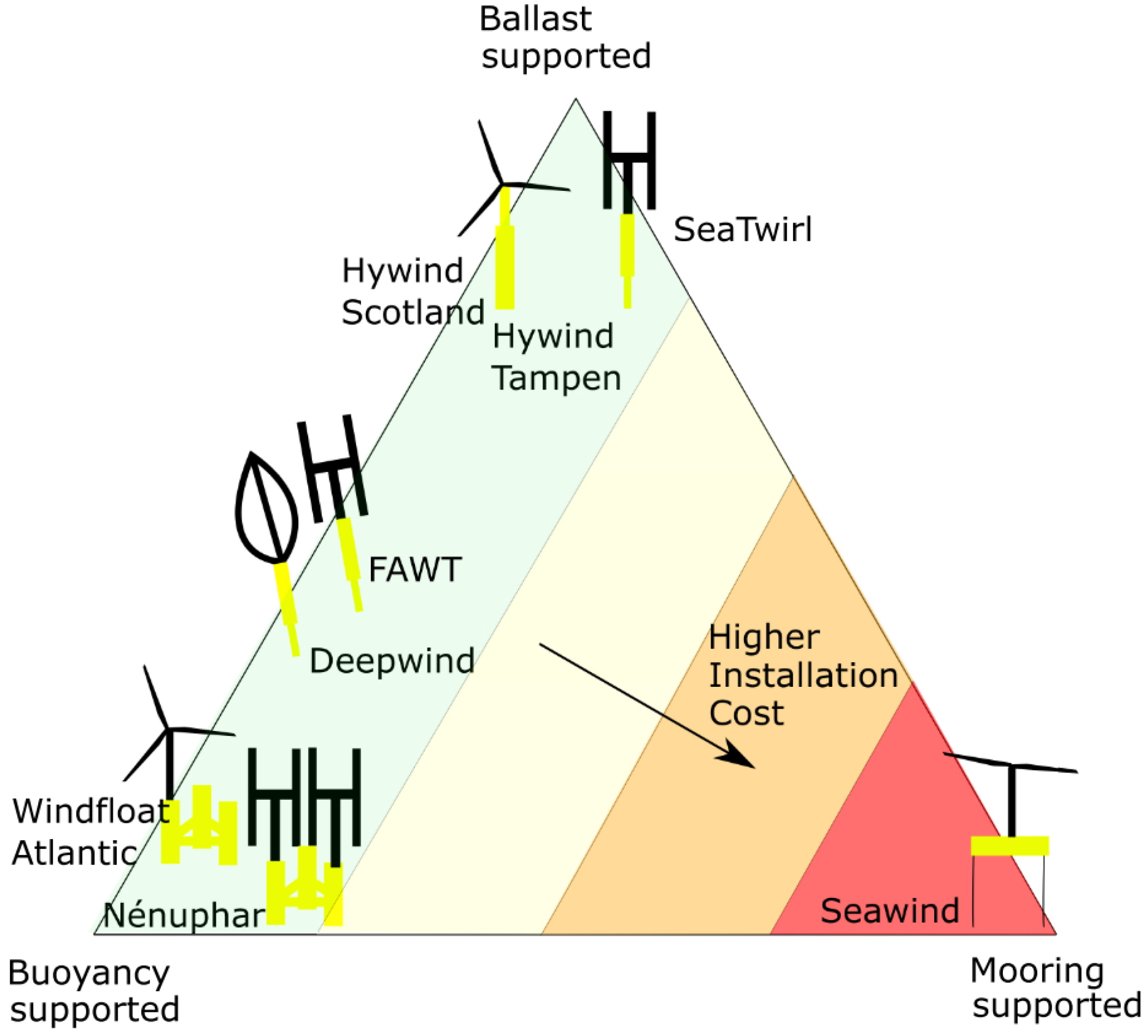Advancements in Offshore Vertical Axis Wind Turbines
Conflicts of Interest
References
- Hand, B.; Cashman, A. A review on the historical development of the lift-type vertical axis wind turbine: From onshore to offshore floating application. Sustain. Energy Technol. Assess. 2020, 38, 100646. [Google Scholar] [CrossRef]
- Arredondo-Galeana, A.; Brennan, F. Floating offshore vertical axis wind turbines: Opportunities, challenges and way forward. Energies 2021, 14, 8000. [Google Scholar] [CrossRef]
- Borg, M.; Shires, A.; Collu, M. Offshore floating vertical axis wind turbines, dynamics modelling state of the art. part I: Aerodynamics. Renew. Sustain. Energy Rev. 2014, 39, 1214–1225. [Google Scholar] [CrossRef]
- Borg, M.; Collu, M. A comparison between the dynamics of horizontal and vertical axis offshore floating wind turbines. Philos. Trans. R. Soc. A Math. Phys. Eng. Sci. 2015, 373. [Google Scholar] [CrossRef] [PubMed]
- Senga, H.; Umemoto, H.; Akimoto, H. Verification of tilt effect on the performance and wake of a vertical axis wind turbine by lifting line theory simulation. Energies 2022, 15, 6939. [Google Scholar] [CrossRef]
- Dyachuk, E.; Goude, A. Simulating dynamic stall effects for vertical axis wind turbines applying a double multiple streamtube model. Energies 2015, 8, 1353–1372. [Google Scholar] [CrossRef]
- Pan, L.; Zhu, Z.; Xiao, H.; Wang, L. Numerical analysis and parameter optimization of j-shaped blade on offshore vertical axis wind turbine. Energies 2021, 14, 6426. [Google Scholar] [CrossRef]
- Ishie, J.; Wang, K.; Ong, M.C. Structural dynamic analysis of semi-submersible floating vertical axis wind turbines. Energies 2016, 9, 1047. [Google Scholar] [CrossRef]
- Borg, M.; Collu, M. Frequency-domain characteristics of aerodynamic loads of offshore floating vertical axis wind turbines. Appl. Energy 2015, 155, 629–636. [Google Scholar] [CrossRef]
- Liu, L.; Zhao, H.; Xu, W.; Yuan, R.; Guo, Y. Structural strength analysis of a tri-Floater floating foundation for offshore VAWT. J. Ocean Univ. China 2018, 17, 753–762. [Google Scholar] [CrossRef]
- Li, Y.; Liu, L.; Guo, Y.; Deng, W. Numerical prediction on the dynamic response of a helical floating vertical axis wind turbine based on an aero-hydro-mooring-control coupled model. Energies 2022, 15, 3726. [Google Scholar] [CrossRef]
- Shires, A.; Kourkoulis, V. Application of circulation controlled blades for vertical axis wind turbines. Energies 2013, 6, 3744–3763. [Google Scholar] [CrossRef]
- Buranarote, J.; Hara, Y.; Furukawa, M.; Jodai, Y. Method to predict outputs of two-dimensional VAWT rotors by using wake model mimicking the CFD-created flow field. Energies 2022, 15, 5200. [Google Scholar] [CrossRef]
- Brownstein, I.D.; Wei, N.J.; Dabiri, J.O. Aerodynamically interacting vertical-axis wind turbines: Performance enhancement and three-dimensional flow. Energies 2019, 12, 2724. [Google Scholar] [CrossRef]
- Furukawa, M.; Hara, Y.; Jodai, Y. Analytical model for phase synchronization of a pair of vertical-axis wind turbines. Energies 2022, 15, 4130. [Google Scholar] [CrossRef]
- Kuang, L.; Lu, Q.; Huang, X.; Song, L.; Chen, Y.; Su, J.; Han, Z.; Zhou, D.; Zhao, Y.; Xu, Y.; et al. Characterization of wake interference between two tandem offshore floating vertical-axis wind turbines: Effect of platform pitch motion. Energy Convers. Manag. 2022, 265. [Google Scholar] [CrossRef]

Disclaimer/Publisher’s Note: The statements, opinions and data contained in all publications are solely those of the individual author(s) and contributor(s) and not of MDPI and/or the editor(s). MDPI and/or the editor(s) disclaim responsibility for any injury to people or property resulting from any ideas, methods, instructions or products referred to in the content. |
© 2023 by the author. Licensee MDPI, Basel, Switzerland. This article is an open access article distributed under the terms and conditions of the Creative Commons Attribution (CC BY) license (https://creativecommons.org/licenses/by/4.0/).
Share and Cite
Micallef, D. Advancements in Offshore Vertical Axis Wind Turbines. Energies 2023, 16, 1602. https://doi.org/10.3390/en16041602
Micallef D. Advancements in Offshore Vertical Axis Wind Turbines. Energies. 2023; 16(4):1602. https://doi.org/10.3390/en16041602
Chicago/Turabian StyleMicallef, Daniel. 2023. "Advancements in Offshore Vertical Axis Wind Turbines" Energies 16, no. 4: 1602. https://doi.org/10.3390/en16041602
APA StyleMicallef, D. (2023). Advancements in Offshore Vertical Axis Wind Turbines. Energies, 16(4), 1602. https://doi.org/10.3390/en16041602




